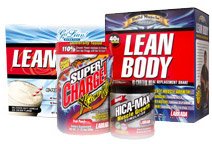
Lift For Length: Build Muscle With Time Under Tension
Ready to maximize your muscle growth? Increase your time under tension and reap the muscle-building rewards! Here's how to do it.
In the wake of several small injuries that have kept me from training as heavy as I normally like, I've begun to lift a little lighter and increase my time under tension (TUT) to keep building muscle. If you believe in lifting heavy all the time, you might be surprised to learn that this technique hasn't decreased my mass at all. In fact, it's brought me incredible results!
Don't take my word for it, though. If you've been training a specific way for a long time, mix it up and try lifting for increased time under tension yourself! I'll explain everything you need to understand time under tension, how to employ it, and how you can increase it during your workouts to maximize your results. Read on—and then work out!
Time Under Tension The Basics
Time under tension is the time your muscle spends under load during a set. This includes the time spent in the concentric (shortening) phase, peak contraction phase, and eccentric (lengthening) phase. So, if you perform a 10-rep set, and each rep takes you 3 seconds to complete, your muscle experiences 30 seconds of time under tension.
If you were to perform that same set but spend 2 seconds lifting the weight (concentric phase), 1 second pausing during peak contraction, and 3 seconds lowering the weight (eccentric phase), those same 10 reps would give you approximately 60 seconds of TUT.

Even though the rep count stayed the same, the muscle spent significantly more time under tension, and that extra time actually translates to a lot more work!
Remember, your muscle can't count. They don't know when you're lifting a 30-pound dumbbell for 10 reps. They simply feel the load created by the weight and the mechanical tension that comes from contracting the muscle under the load. Therefore, to increase the work done by your muscles, either increase the load or increase the time the muscle is placed under this load.
Best Rep Range and TUT for Hypertrophy

We already know that progressively overloading your muscles will force them to adapt and subsequently grow. Furthermore, research has proven time and time again that the optimal rep range for muscular growth, or hypertrophy, is between 8 and 12 reps. What isn't so clear, though, is the optimal range of TUT for hypertrophy.
Legendary coach Charles Poliquin is a training pioneer who focused on manipulating time under tension. Through his experience and research, he was able to develop optimal ranges of time under tension for particular training goals.
For muscular hypertrophy, he found that 30-70 seconds per set was optimal. For strength and size gains, or functional hypertrophy, Poliquin suggests training on the lower end of that range, around 30-50 seconds. If you want maximum hypertrophy without a strength emphasis, train on the higher end of that range, or around 50-70 seconds.
Armed with this knowledge, all you need is a little math to figure out the sets, reps, and TUT range for maximum hypertrophy. Need a hint? Perform sets of 8-12 reps, and take 4-6 seconds to perform each rep.
Time Under Evidence
I've seen excellent results from increasing my TUT. I've gained strength and size, but certainly not by chance. In fact, there's some excellent research on the power of TUT training for muscular size.
In 2012, researchers performed a study to examine the effects of increased time under tension on protein synthesis, a major indictor of muscle growth.1 In this study, eight males who had been training legs twice per week for at least two years performed 3 sets of single-leg extensions using 30 percent of their 1-rep max. On one leg, the participants performed sets with six-second concentric and six-second eccentric actions to failure. On the other leg, they performed sets with 1-second concentric and 1-second eccentric actions to failure.
Researchers then took needle biopsies of the muscle tissue in both legs 6, 24, and 30 hours after exercise. The results between the two methods were startling: After 6 hours, exercise-induced rates of mitochondrial and sarcoplasmic protein synthesis were elevated by 114 percent in the leg that did slow contractions, and only 77 percent in the leg that did faster contractions. After 24-30 hours, mitochondrial protein synthesis rates were elevated at 175 percent and 126 percent, respectively.
These results suggest that increased time under tension may lead to increased muscle protein synthesis and faster onset of this increased synthesis.
Techniques to Increase TUT
Now that you understand how increased time under tension may increase your protein synthesis and help you build muscle, here are ways to incorporate it into your workout.
Altered tempo
You can create the most microtrauma in your muscles during the eccentric part (lowering portion) of an exercise. In my experience, I've had the most success using approximately three seconds to complete the eccentric component of a lift.

Once at the bottom of the rep, pause for 1-2 seconds. Pausing removes all momentum and stored energy from your working muscle, which means you receive no extra help when you start moving the weight. The pause also truly gives you a moment to mentally activate your working muscle for the concentric portion of the lift. This increased awareness, or mind-muscle connection, will help you recruit the proper muscle fibers and expedite results.
When beginning the concentric portion of an exercise, focus on being powerful and explosive without forgetting your form. This part of the lift should take no longer than about one second, but will become slightly longer as your body fatigues. Once at the top of the rep, create maximal tension by pausing for a full second at the peak of the rep.
Putting all of this together results in about 5-6 seconds per rep—a perfect combination for performing 8-12 reps and keeping your muscles under tension for 30-70 seconds per set.
Dropsets
To perform a dropset, lift a selected weight until you reach the point of failure. Then, lighten the weight and continue lifting until you perform a predetermined amount of reps or hit failure again. You can continue dropping in this fashion as long you like, to put more tension on your muscles, but bear in mind Poliquin's suggestions for TUT.
When employing this technique, I recommend selecting a weight you can perform 4-6 times before reaching failure. Follow it by using a weight you can lift for 10-12 reps before reaching failure.
Doing dropsets will subject your body to heavier poundages necessary for maximal tissue breakdown, but will keep the target muscle under tension for the optimal amount of time.
Partial reps and forced reps
Partial reps are exactly what they sound like: reps that aren't performed in a full range of motion. For pushing movements, that means you don't fully lock out any joints. For pulling movements, you won't hit peak contraction. Performing reps shy of completion keeps constant tension on the muscle and allows you to handle heavier weights.

To do forced reps, have a spotter assist you past the point of failure. This technique extends the time spent under tension and allows you to use heavier weights. Forced reps are very strenuous on your muscles, tendons, and nervous system, so be sure to use them sparingly.
Maximize TUT, Maximize Growth!
The amount of time you put your muscles under tension is a critical component of muscle growth. Anyone, from the gym newb to the hardcore lifter, can benefit from mixing some increased time under tension techniques into his or her program.
Not only will the increase in time under tension spur new muscle growth, but it will force you to check your form and use more appropriate weights. So my challenge to you for this week's training is to try some of these techniques and increase the time under tension your muscles experience. I think you'll reap some excellent rewards.
As always, if you have any questions, let me know in the comments section below!
References
- Burd, N. A., Andrews, R. J., West, D. W., Little, J. P., Cochran, A. J., Hector, A. J., ... & Phillips, S. M. (2012). Muscle time under tension during resistance exercise stimulates differential muscle protein sub?fractional synthetic responses in men. The Journal of Physiology, 590(2), 351-362.




